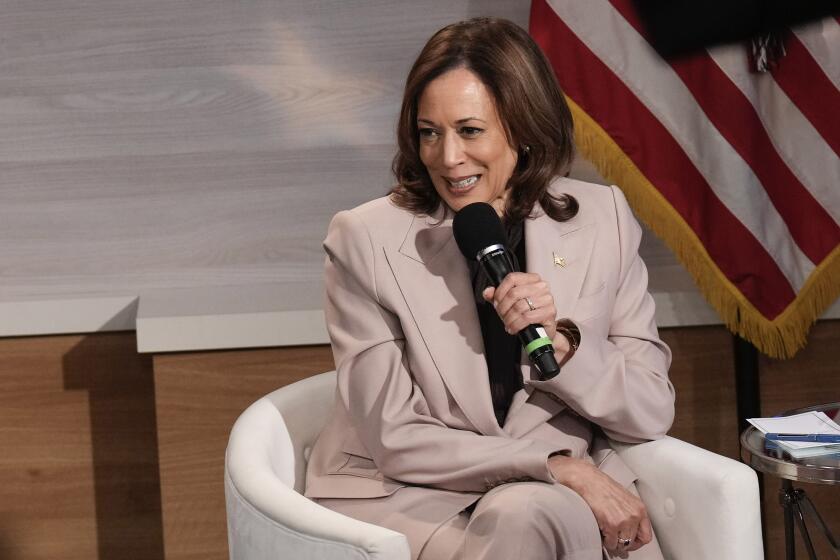Hawaiians Are Hustling to Get Spaceport on Big Island Site
A barren, wind-swept point near this small community will be transformed into the nation’s first commercial spaceport during the next few years if the state of Hawaii has its way.
State officials from the governor down are aggressively courting the international space industry with a multimillion-dollar program aimed at paving the way for companies to come here and build whatever they need to launch small payloads into orbit.
The proposed site would offer the unique advantage of being the only prospective spaceport in the nation where it would be possible to launch payloads into either polar or equatorial orbits, a flexibility that could save the launch industry millions of dollars in the years ahead because they could use the same facilities for a wide variety of launches.
The state is spending about $6 million on feasibility and environmental studies, plus limited site preparation, but the goal is to get commercial companies to actually build the facilities for their own use.
“Hawaii would be a one-stop shopping center, offering either equatorial or polar orbits,” said George Meade, who is heading the project for the state. “The critical question is, is there a market? I have a feeling there is, but don’t ask me to prove it yet.”
Convinced that such an industry would be good for this area of Hawaii’s Big Island, which faces a chronic unemployment problem, the state commissioned the consultant firm of Arthur D. Little Inc. to study the concept. The Cambridge-based firm in February gave the project a ringing endorsement and narrowed the number of prospective sites to two, both of them near this community on Hawaii’s South Point.
Interest in the project has been shown by small entrepreneurial companies like American Rocket Co. of Camarillo, which is set to begin launching its small rockets soon from Vandenberg Air Force Base, but no contracts have been signed. And the aerospace giants have been anything but enthusiastic.
“Nobody is banging down our door,” said Hawaiian Rep. Andrew Levin, whose legislative committee must approve the project and whose district includes the site.
In 1982, residents of Levin’s district succeeded in beating back a proposal by former astronaut Donald (Deke) Slayton to build a commercial spaceport there in a brouhaha that left the veteran of the Apollo-Soyuz space rendezvous somewhat shaken.
“There’s a very vocal element that’s highly opposed to any changes, and they just don’t want anything to do with it,” said Slayton as he recalled the stormy exchanges six years ago. Slayton, president of Space Services Inc. of Houston, which is assembling a family of small rockets for commercial launches, is still interested in Hawaii but he remembers all too vividly the emotional firestorm that forced him to abandon his plans once before.
There is some evidence, however, that opposition has abated. Gov. John D. Waihee has made the spaceport one of his top priorities, and state officials have succeeded in lining up considerable local support. A recent survey of 800 Hawaiian residents conducted for the state Department of Business and Economic Development showed 60% statewide favor the spaceport, and 54% of the people on the Big Island support it.
An environmental impact study was authorized last month by the Legislature, and state officials are already insisting that no one in the area needs to worry about debris from an errant rocket.
The area is sparsely populated, with one resident for every 174 acres, and because of the location of the site all launches would be over water--to the south for polar orbits and to the east for equatorial orbits.
The site offers several advantages over existing launch facilities on the mainland.
Launch pads close to the Equator benefit from the rotation of the Earth in that the planet’s spin acts like a slingshot. The closer to the Equator, the less thrust required for launching. The site here is 19 degrees north of the Equator, and that puts it 8 degrees closer than the Kennedy Space Center in Florida.
Equally important, rockets could be launched from the same pads into polar orbit, something that cannot be done from Florida because that would send them over populated areas.
“We are very interested,” said Jim Bennett, vice president of American Rocket Co., one of the smaller firms that has expressed an interest in building facilities in Hawaii. “We would like to have a couple of pads, and we could certainly afford to do that. We’re talking no more than a couple of million dollars, not tens of millions.” The state has estimated that it would take between $30 million and $50 million to set up the spaceport, and that could involve several companies pooling their resources to build shared facilities.
Bennett’s enthusiasm over Hawaii is not shared by the giants in the aerospace industry, however.
Nearly half the communications satellites launched by the United States have been built by Hughes Aircraft Co. of El Segundo. However, when asked if Hughes would be interested in building its own launch facilities in Hawaii, a company spokesman said nobody in the firm even wanted to discuss it.
“We’re not in the launch vehicle business,” the spokesman said.
Similarly, a spokeswoman for Martin Marietta’s Astronautics Group in Denver, one of the nation’s leading rocket builders, said: “We don’t have any plans to build a facility in Hawaii. We aren’t in the business of building launch sites.”
Martin Marietta already has an agreement with NASA to use launch facilities at Cape Canaveral, Fla., and although the firm sees Hawaii as “a perfect site,” the spokeswoman said, “we don’t need it.”
In a way, Hawaii is racing against time because other areas in the world are also hoping to build commercial launch facilities, and state officials believe that if they are to succeed, they need to be first at the starting gate.
Australia, for example, has formed a consortium of 64 companies and organizations to explore the possibility of building a commercial spaceport at Cape York on that continent’s north shore. And Indonesia, which has an advantage over both Hawaii and Australia in that it straddles the Equator, recently launched a major effort to build an international facility in that island nation.
The only other site located on the Equator is the European Space Agency’s spaceport in French Guyana, from which Ariane rockets launch payloads into equatorial orbit.
If Hawaii is to get a piece of the action, it must move quickly, state officials believe.
“It’s worth going after,” said Meade, the state official charged with getting it.
More to Read
Sign up for Essential California
The most important California stories and recommendations in your inbox every morning.
You may occasionally receive promotional content from the Los Angeles Times.










